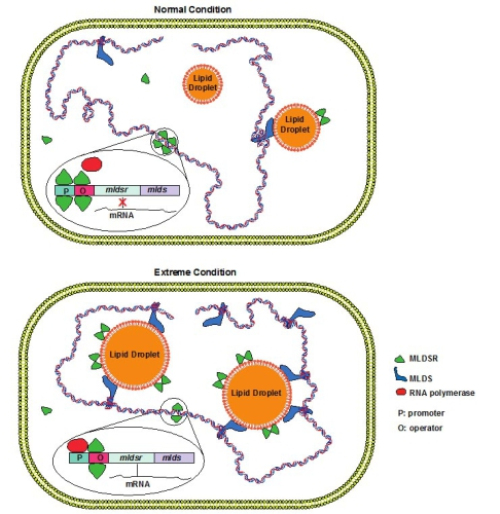Chinese Scientists Found That Bacterial Lipid Droplets Bind DNA And Involve in Transcriptional Regulation
The lipid droplet is a spherical organelle with neutral lipid core, phospholipid monolayer membrane and peripheral proteins. The unique of lipid droplet monolayer phospholipid membranes, particularly the specific localization of the resident proteins to lipid droplets, indicates that lipid droplets are very specific in cells and distinct from other bilayer phospholipid membrane organelles. It has been known that lipid droplets are involved in lipid metabolism and storage, however, the other functions of lipid droplets, especially in bacteria, still need to be explored.
Recently, the novel functions of lipid droplets in bacteria are reported. In the new study published online in Nature Communications ("Bacterial lipid droplets bind to DNA via an intermediary protein that enhances survival under stress"), LIU Pingsheng’s group in Institute of Biophysics, Chinese Academy of Sciences presents an important finding: bacterial lipid droplets can bind to and protect genomic DNA through its major protein MLDS, and participate in transcriptional regulation through MLDSR protein, which is conducive to the bacterial survival in extreme environments.
The emergence of bacterial lipid droplets provides bacteria with a new way of cell compartmentalization, which is different from the plasma membrane. The previous work in LIU Pingsheng’s group revealed the lipid and protein composition of bacterial lipid droplets and found a protein, MLDS that controls lipid droplet size.
Through amino acid sequence analysis of MLDS, in this study, they found that the protein contained DNA binding motif. Therefore, they hypothesized that bacterial lipid droplets may bind genomic DNA by MLDS. Using super-resolution 3D-SIM imaging and co-localization analysis of wild type bacteria and MLDS knockout mutant, as well as in vitro adiposome binding assay, they found that genomic DNA localizes to lipid droplets via MLDS.
Subsequently, the researchers found that MLDS-mediated binding of genomic DNA to lipid droplets enhances the bacterial survival rate in UV exposure and extremely low nitrogen conditions because of avoiding bacterial DNA damage, which suggests that the binding of DNA to lipid droplets protects genomic DNA and increases the bacterial survival in extreme environments.
Furthermore, using protein localization analysis, EMSA, in vitro transcription assay, and in vitro adiposome binding assay, they further revealed that bacterial lipid droplets not only protect DNA, but also are involved in DNA transcriptional regulation by controlling the effective concentration of a transcription factor, MLDSR, that regulates the expression of MLDS.
The study explores that bacterial lipid droplets (the triacylglycerol storage organelle) bind and protect genomic DNA, and are involved in transcriptional regulation, suggesting that the organelle participates in nucleic acid handling through the specificity of their monolayer phospholipid membranes, which in turn improves the efficiency and specificity of the two major determinants of life - metabolism and inheritance. Therefore, the emergence of bacterial lipid droplets may be the proto-form of the nucleus, which is a milestone of cell evolution from prokaryotes to the eukaryotes.
This work was supported by grants from the Ministry of Science and Technology of China, from the National Natural Science Foundation of China and from Chinese Academy of Sciences. Two patents related to this research have been applied.

Figure: The model of bacterial lipid droplets binding genomic DNA and involving in transcriptional regulation (Image by IBP)
Contact:
LIU Pingsheng
Princiapl Investigator
National Laboratory of Biomacromolecules, IBP
E-mail:pliu@sun5.ibp.ac.cn
Tel:86-10-6488-8517(o)-8521(L)
Fax:8610-64888517

